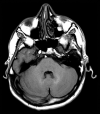Gadolinium Retention after Contrast-Enhanced Magnetic Resonance Imaging: A Narratative Review
- PMID: 35283709
- PMCID: PMC8869263
- DOI: 10.4103/sjmms.sjmms_198_21
Gadolinium Retention after Contrast-Enhanced Magnetic Resonance Imaging: A Narratative Review
Abstract
Over the past five years, several studies have reported deposition and retention of gadolinium in the brain after administration of gadolinium-based contrast agents (GBCAs) during radiological procedures. Patients with renal insufficiency cannot filter gadolinium efficiently; however, gadolinium is also retained in the brain of some adults and pediatrics with no renal impairment. In the literature, data is mostly available from retrospective magnetic resonance imaging (MRI) studies, where gadolinium deposition may be indirectly measured by evaluating changes in T1 signal intensity in the brain tissues, particularly in the deep gray matter such as the dentate nucleus and/or globus pallidus. Many pathological studies have reported a direct correlation between T1 signal changes and gadolinium deposition in human and animal autopsy specimens, which raised concerns on the use of GBCAs, particularly with linear chelators. The association between gadolinium accumulation and occurrence of physical and neurological side effects or neurotoxic damage has not yet been conclusively demonstrated. Studies have also observed that gadolinium is deposited in the extracranial tissues, such as the liver, skin, and bone, of patients with normal kidney function. This narrative review describes the effects of different types of GBCAs in relation to gadolinium deposition, evaluates current evidence on gadolinium deposition in various tissues of the human body, and summarizes the current recommendations regarding the use of GBCAs.
Keywords: Diagnostic imaging; T1 hyperintensity; gadolinium adverse effects; gadolinium deposition; gadolinium retention; gadolinium-based contrast agents (GBCAs).
Copyright: © 2022 Saudi Journal of Medicine & Medical Sciences.
Conflict of interest statement
There are no conflicts of interest.
Figures
Similar articles
-
Gadolinium Deposition in Brain: Current Scientific Evidence and Future Perspectives.Front Mol Neurosci. 2018 Sep 20;11:335. doi: 10.3389/fnmol.2018.00335. eCollection 2018. Front Mol Neurosci. 2018. PMID: 30294259 Free PMC article. Review.
-
Brain tissue gadolinium retention in pediatric patients after contrast-enhanced magnetic resonance exams: pathological confirmation.Pediatr Radiol. 2020 Mar;50(3):388-396. doi: 10.1007/s00247-019-04535-w. Epub 2020 Jan 27. Pediatr Radiol. 2020. PMID: 31989188
-
The presence of the gadolinium-based contrast agent depositions in the brain and symptoms of gadolinium neurotoxicity - A systematic review.PLoS One. 2017 Feb 10;12(2):e0171704. doi: 10.1371/journal.pone.0171704. eCollection 2017. PLoS One. 2017. PMID: 28187173 Free PMC article.
-
Gadolinium deposition within the dentate nucleus and globus pallidus after repeated administrations of gadolinium-based contrast agents-current status.Neuroradiology. 2016 May;58(5):433-41. doi: 10.1007/s00234-016-1658-1. Epub 2016 Feb 12. Neuroradiology. 2016. PMID: 26873830 Review.
-
Gadolinium deposition in the brain: association with various GBCAs using a generalized additive model.Eur Radiol. 2017 Aug;27(8):3353-3361. doi: 10.1007/s00330-016-4724-5. Epub 2017 Jan 12. Eur Radiol. 2017. PMID: 28083696
Cited by
-
Gadolinium toxicity: mechanisms, clinical manifestations, and nanoparticle role.Arch Toxicol. 2025 Jul 3. doi: 10.1007/s00204-025-04124-x. Online ahead of print. Arch Toxicol. 2025. PMID: 40608128 Review.
References
-
- Mattson J, Simon M. Dean Book Co: Bar-Ilan University Press; 1996. The Pioneers of NMR and Magnetic Resonance in Medicine: The Story of MRI.
-
- Marckmann P, Skov L, Rossen K, Dupont A, Damholt MB, Heaf JG, et al. Nephrogenic systemic fibrosis: Suspected causative role of gadodiamide used for contrast-enhanced magnetic resonance imaging. J Am Soc Nephrol. 2006;17:2359–62. - PubMed
-
- American College of Radiology. Committee on Drugs and Contrast Media. ACR Manual on Contrast Media. [Last accessed on 2019 Sep 20]. Version 10.3. Available from: https://www.acr.org/-/media/ACR/Files/Clinical-Resources/Contrast_Media.pdf .
-
- European Medicines Agency. Questions and Answers on the Review of Gadolinium-Containing Contrast Agents. 2009. [Last accessed on 2018 May 26]. Available from: http://www.ema.europa.eu/docs/en_GB/document_library/Referrals_document/... .
-
- Gadolinium-Based Contrast Agents & Nephrogenic Systemic Fibrosis FDA Briefing Document. Joint Meeting of the Cardiovascular and Renal Drugs and Drug Safety and Risk Management Advisory Committee. 2011. [Last accessed on 2018 May 26]. Available from: http://www.fda.gov/downloads/AdvisoryCommittees/CommitteesMeetingMateria... .
LinkOut - more resources
Full Text Sources
Miscellaneous

